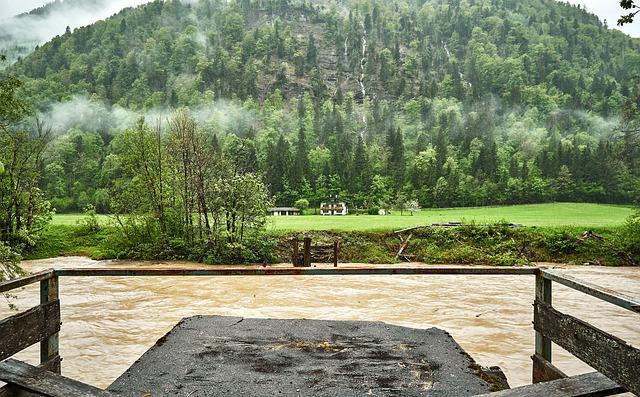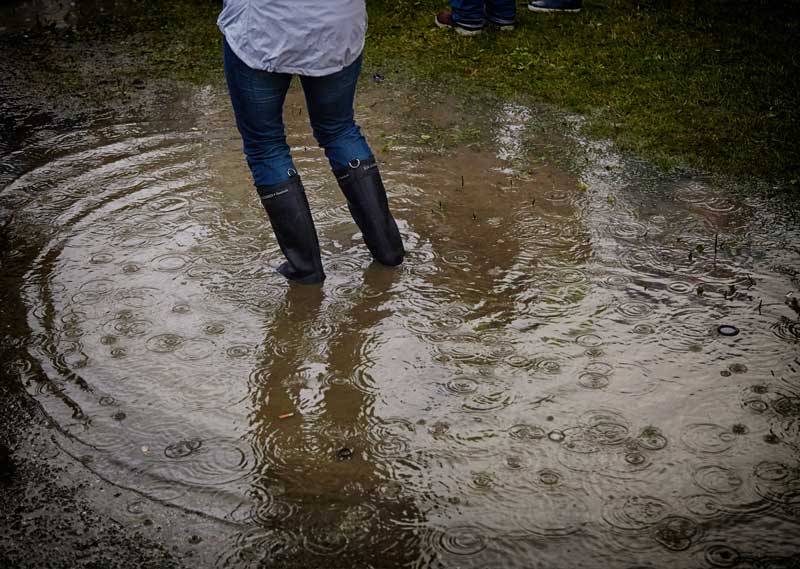Weather patterns are becoming more and more unpredictable. It’s not unusual to get prolonged periods of drought followed by flash floods, which spells all sorts of trouble for your roof, conservatory and garden.
In fact, garden flooding is a major issue for homeowners and one they need to think about long and hard, as it could cause serious damage to their property. So, how do you fix a flooded garden?
We decided to look carefully into the causes of a flooded garden, how to deal with the situation and how to stop garden flooding. Here’s what we found.
Table of contents
- Why does my garden flood?
- How do you drain a waterlogged garden?
- How do you improve drainage in waterlogged soil?
- The importance of improving lawn drainage
Why does my garden flood?
If you have a waterlogged garden, the water won’t be able to drain away, drowning plant roots and creating an unhealthy, swamp-like mess.
Heavy rain is one of the primary causes, but it’s far from the only one. So, why else did it happen in the first place?
Your grounds are suffering from soil composition
Soil composition is one of the most common garden drainage problems. Clay-rich soil can be particularly problematic, as it tends to become highly saturated and compacted in conditions of sustained rainfall – so much so that water can no longer drain through. Uneven terrain will exacerbate the issue.
The property might be in a high water table area
The water table refers to the layer of soil that groundwater typically reaches. While this varies depending on rainfall and the time of year, a high water table means your garden would be prone to flooding during the autumn and winter.
The drainage system for the garden might be blocked
Over time, silt accumulates in drainage pipes, and ground movement exacerbates the problem. The system could also be damaged, especially if it’s older.
The key thing to take away from this is if garden flooding is something you face time and again, you have to identify the chief cause to deal with it appropriately.

How do you drain a waterlogged garden?
Before considering any permanent garden flooding solutions, you must remove the standing water in the garden.
If you’re convinced that overflowing drains located outside your garden caused the flood, you must contact your water company immediately.
If a significant amount of water is concentrated in a specific area, you can use an electric pump to pump it out. You can also use buckets, but that will take a lot longer.
However, if the water is at a uniform level across the entire garden, you should keep off the grass and soil until it’s reasonably dried out. Use existing paths only. Why? Well, the thing is, if you walk on waterlogged soil, it will compact, or you might break up its structure. So, as frustrating as it might sound, you’ll have to wait until the soil is in workable condition.

How to clean the garden after a flood
Now all the preparation is out of the way, it’s time to clean up! Start with any debris, followed by damaged plant shoot. The Royal Horticultural Society recommends not to eat any edible crops, including root crops, as the water may contain disease spores. For the same reason, it’s advisable not to grow any salads for up to two years after the flood.
This may seem like a long time, but as the saying goes – “it’s better to be safe than sorry.”
Once you’ve tidied up, aerate the soil using a pitchfork. To do so, poke deep holes in the ground at regular intervals. This will also boost drainage.
Then, you should add organic matter, such as compost. Composting is a great idea even if your garden is not prone to flooding, as compost helps you avoid unnecessary waste and is an excellent way of enriching the soil, improving its structure and living sustainably.
Having done all that, you need to consider long-term garden drainage solutions. We’ll look at some of the more popular ones next.
How do you improve drainage in waterlogged soil?
One of the best things you can do to avoid repeated garden flooding is to plant smart. This will have the additional benefit of improving the overall ambience of your garden. Trees are especially helpful in breaking up soil and improving drainage thanks to their deep roots. Willows, in particular, love plenty of water and will make a fine addition to your garden.
It’s also worth knowing plants like flag irises and violets can withstand a fair amount of waterlogging.
You might also want to install water butts. These will help reduce the runoff into your drains. You can then use that water for other purposes, such as watering your plants during dry spells or washing your car.
Last but not least, you can create simple ditches or French ditches (also known as dry wells) or even a garden land drain (or two). Keep in mind that, depending on the size of your garden, this might be a fairly big project. So, it’s best to rely on certified landscapers to do it properly and safely.

The importance of improving lawn drainage
A flooded garden is not a pleasant sight. You’ve worked hard to make yours grow, and now all your efforts have gone to waste. You’re going to have to start from scratch.
Unfortunately, with extreme weather becoming more common, garden flooding is something we all have to consider seriously.
The bottom line is it all comes down to planning. Think ahead and prepare yourself by improving flood defence, drainage, planting suitable plants, composting and cultivating the soil.














